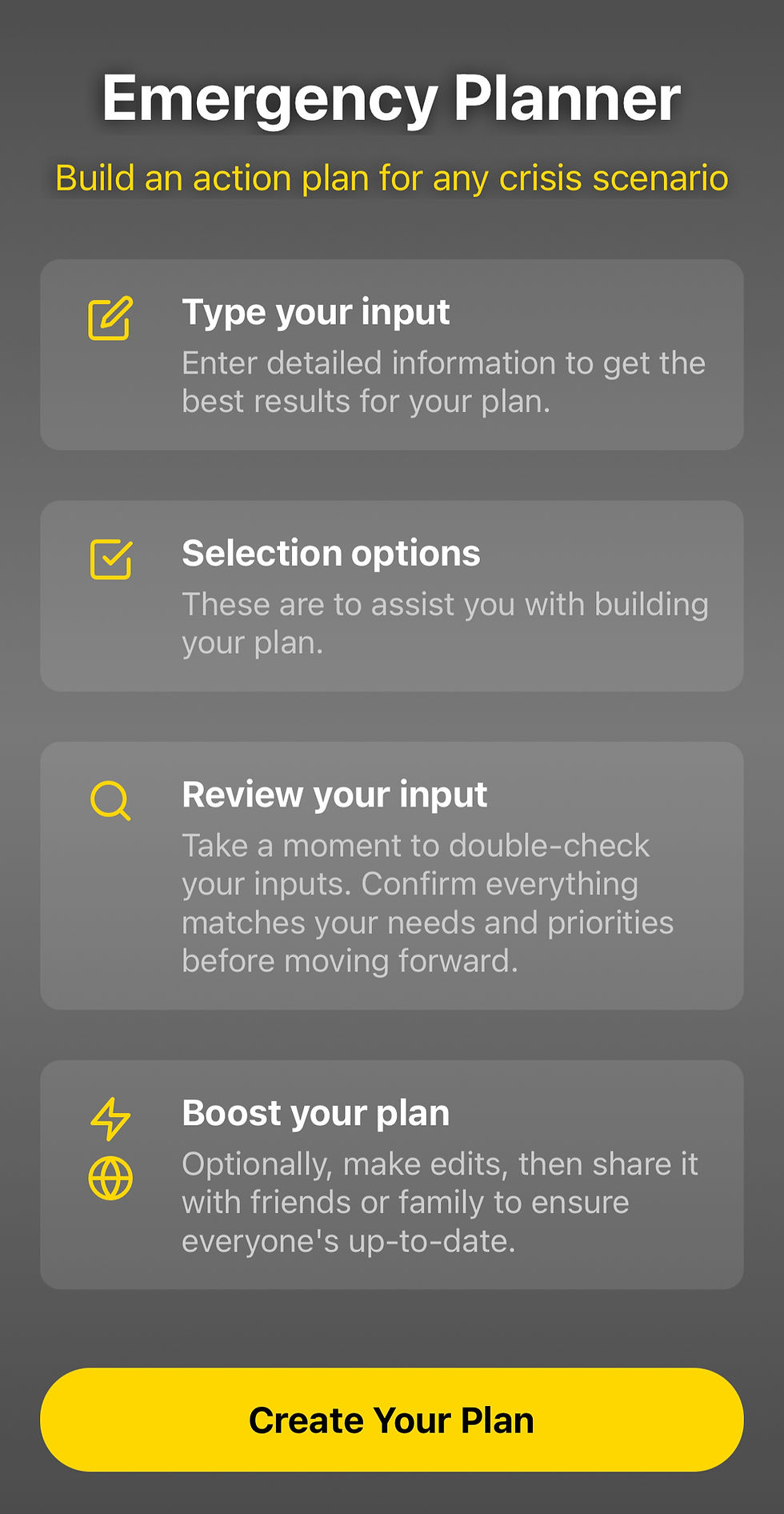

Building
Emergency plans: being prepared
Emergencies are unpredictable. They can strike at any time, turning our world upside down in an instant.
Being prepared for an emergency is not just about survival. It's about ensuring the safety and well-being of you and your loved ones.
This guide will walk you through the process of building a comprehensive emergency plan. It will cover everything from identifying potential emergencies to assembling an emergency kit.


Understanding the Importance of an Emergency Plan

An effective family emergency plan acts as a safety net during unpredictable times. It can significantly reduce panic and confusion when the unexpected happens. By having a plan, you set a clear course of action, ensuring everyone knows their role and responsibilities.
A well-thought-out plan boosts your family's readiness and confidence. It provides peace of mind, knowing you're equipped to protect your loved ones. Whether it's a natural disaster or a medical crisis, a concrete plan is crucial for safeguarding your family's security and health.
Identifying Potential Emergencies and Their Unique Requirements
Every person faces different potential emergencies. Natural disasters like floods, earthquakes, or tornadoes have specific needs. Each requires tailored preparations to ensure safety and survival. Recognizing these threats is the first step to being ready.
Understanding the unique requirements of each emergency is key. Some situations might demand evacuation, while others need sheltering in place. Knowing what actions to take can reduce fear and confusion.
Tailor your emergency plan to suit the specific risks in your area and family situation. Being aware and informed can make all the difference when an emergency strikes.


Selection options in the app include:
- Hurricane
- Tornado
- Power Blackout
- Earthquake
- Wildfire
- Floods
- Nuclear war
- Global Pandemic
- Economic Collapse
Steps to Creating Your Family Emergency Plan
Creating a family emergency plan involves careful thought and organization. Start by discussing potential emergencies with your family. Everyone should understand what to expect and what roles they might have.
Next, outline a step-by-step response for each emergency type. Simple, clear directions minimize panic and ensure all family members know what to do. Draft these steps in writing, making them easily accessible.
It's vital to establish a communication strategy. Compile a list of essential contact numbers, including local emergency services and out-of-town family members. Share these contacts with all family members.
Incorporate the following elements into your plan:
-
Designated meeting spots both inside and outside your home
-
Escape routes for quick evacuation
-
Location and contents of your emergency kit
-
Procedures for communicating during and after an emergency
-
Steps for securing your home
Finally, regularly revisit and revise your plan. Update it as family dynamics change or new threats arise. Keeping the plan current ensures your family's safety and peace of mind.

Utilizing an Emergency Plan Template

An emergency plan template simplifies the planning process. It provides a structured format to ensure you include all essential details. Using a template saves time and helps prevent oversights. Choose a template that suits your family’s needs.
In The Prepper APP, we take emergency planning to the next level with our fully customizable Emergency Plan Builder. Whether you're new to emergency preparedness or a seasoned prepper, the app is designed to make the process as easy and effective as possible.
You can choose between two approaches:
-
Preset Options: Select from guided templates that walk you through each critical step. These options help ensure you don’t miss any essential details and provide helpful prompts to guide your planning process.
-
Fully Customizable Plans: If you know exactly what you want to include or want to add unique details, you can type directly into the text fields to create a plan tailored to your specific needs and ideas.
The Emergency Plan Builder in The Prepper APP focuses on the following core components to ensure you're prepared for any situation:
1. Choosing/Describing the Emergency: Define the type of emergency you’re preparing for, whether it's a natural disaster, a blackout, or another crisis.
2. Location: Plan for where you’ll be when the emergency happens—at home, work, school, or traveling.
3. Priorities: Identify your first priorities, such as gathering supplies, ensuring safety, or securing vital resources.
4. Evacuation: Create a detailed evacuation plan, including routes, transportation, and safe zones.
5. Family Coordination: Outline how you’ll communicate and coordinate with family members, ensuring everyone stays informed and connected.
6. Last Actions: Detail your final steps, such as securing your property, locking down critical supplies, or ensuring that no one is left behind.

Communication: The Heart of Your Emergency Plan
Effective communication is vital in any family emergency plan. Ensuring everyone knows how to stay in touch is crucial. Family members should have a list of essential phone numbers. This list can include contacts for local and out-of-town relatives.
Another important element is having a designated family member to act as the primary contact. This person coordinates communication if family members become separated during an emergency. Using texting or messaging apps can also be beneficial, especially if phone lines are congested. Consistently updating your communication plan ensures readiness and quick response in a crisis.
Designating Safe Spots and Establishing Contacts
Choosing safe spots is crucial for family safety. Identify a secure location inside your home for emergencies like storms. Also, establish an outside meeting point, such as a neighbor’s porch, for events like fires.
Equally important is setting up an out-of-town contact person. This individual can relay information and updates among family members during widespread emergencies. Familiarize all family members with these designated contacts and locations.
This preparation ensures everyone knows where to go and whom to call when danger arises. Regular reminders strengthen understanding and readiness in stressful situations.
Assembling Your Family Emergency Kit
An essential part of emergency preparedness is having a well-stocked emergency kit. This kit should be easily accessible and contain items necessary for survival in various situations. Each family member's needs should be considered when assembling your kit.
Here's a list of crucial items to include:
-
Non-perishable food and water
-
Flashlight and extra batteries
-
First aid supplies
-
Necessary medications
-
Personal hygiene items
-
Important documents

Remember to periodically check and update your kit. Expired items should be replaced, and supplies adjusted for family changes. Keeping your kit ready at all times ensures you have the essentials in case of any family emergency.
Including Special Needs and Pets in Your Plan
When crafting a family emergency plan, it's crucial to accommodate family members with special needs. Their requirements may include specific medications, medical equipment, or dietary necessities. Planning for these needs ahead of time will help ensure their safety and comfort.
Pets are often beloved family members and should also be included in your emergency plan. Prepare a pet-specific kit that contains food, water, and any medications they require. Identify pet-friendly shelters or make arrangements with friends or family who can help during an emergency. Taking these steps ensures everyone, including your pets, is ready for unforeseen events.
Practicing and Reviewing Your Emergency Plan
Once you've created an emergency plan, practice it regularly. Conducting drills helps every family member understand their role during an emergency. Familiarity with the plan can significantly reduce panic and confusion when facing real threats.
Reviewing the emergency plan periodically is equally important. Family dynamics and needs can change, necessitating updates to the plan. Ensure all contact information is current and emergency kits are well-stocked. By regularly practicing and reviewing your emergency plan, your family stays prepared for various situations, ensuring their safety and resilience in the face of adversity.
Leveraging Technology and Community Resources
In today's digital age, technology can be a crucial ally in emergency preparedness. Apps designed as emergency plan builders provide templates and reminders, helping you manage your family's readiness efficiently. Digital tools can also facilitate communication during crises, ensuring all family members remain informed and connected.
Community resources can enhance your emergency plan. Local safety programs offer valuable information and support during emergencies. Participating in community initiatives not only strengthens your family's preparedness but also builds a network of neighbors who can assist each other in times of need. Utilizing both technology and community resources empowers families to face emergencies with confidence.
Leveraging Technology and Community Resources
Preparing for emergencies is not just a one-time task. Situations and family needs can change, making it crucial to regularly update your emergency plan. Keep information current to address any new challenges or family dynamics.
Adaptability is your best tool in unpredictable scenarios. Being prepared to alter your plan when circumstances shift can mean the difference between chaos and calm. By revisiting and refining your emergency plan, you ensure that your family remains safe, informed, and ready to face whatever comes their way with resilience and confidence.



